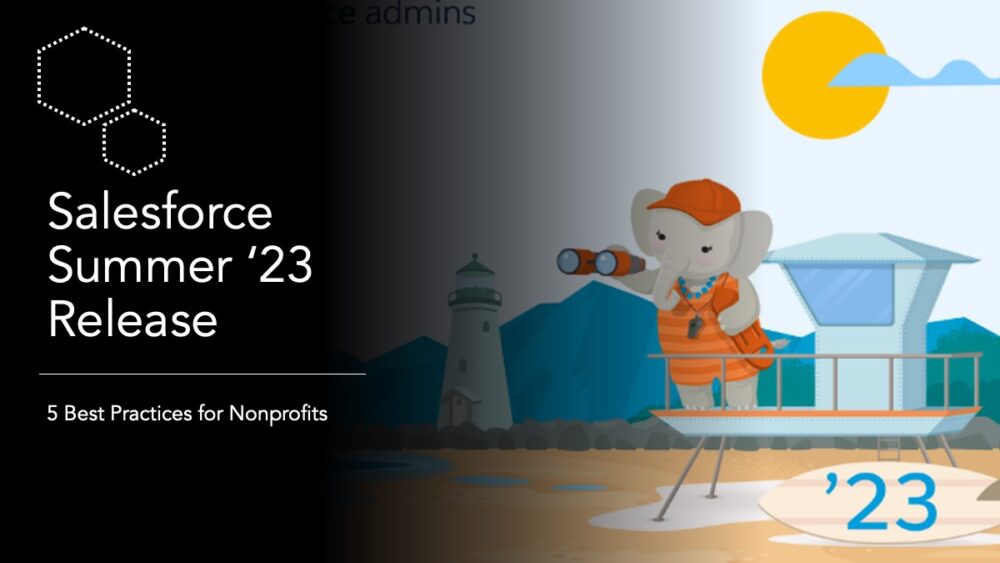
With the arrival of summer, we welcome the latest Salesforce release – Summer ’23. This season is not only a time for fun activities with family and friends, it’s also an opportunity to cultivate good habits in your Salesforce org that will benefit you throughout the year. In this blog post, we will highlight the top 5 best practices for nonprofits to adopt with the Salesforce Summer ’23 release.
Best Practice 1: Move Automation to Flow
Have you converted your custom workflow rules and process builders to Flow yet? If not, now is the time to start. As of this Summer release, it’s no longer possible to create a new Process in Process Builder. The Migrate to Flow tool was introduced in a previous release, now the tool has been improved to include scheduled actions.
There has also been significant updates to the built-in Email Action in Flow. One of the biggest frustrations in the old workflow rules was that Email Alerts didn’t log any history on the record that triggered the alert. The Idea on the IdeaExchange to change this was started in 2007 and had over 82,000 votes! Summer ‘23 finally delivers and you can now use the flow Send Email action with a simple option to log the email to the record.
Each release, Salesforce makes flows easier to understand and follow, and this release is no exception. Summer ‘23 simplified the Flow Builder canvas to require less scrolling and provides more visual feedback.
Why we’re excited
Beyond the Horizon (BTH) has invested a lot in flow automation. There’s no better way in Salesforce to ensure high quality, efficient data and consistent experiences. These incremental improvements make working with Flow even easier.
Best Practice 2: Keep Reports Organized
Until this release, Reports and Dashboards could be a bit of a mess. Hard to decide which folder they belonged so the tendency was to pile them into “junk drawer” type folders and search for them later. Summer ‘23 introduces a new unified Analytics home page making it much easier to see reports at a glance without relying on a static list of folders. You can not only see the most recently updated reports, you can see reports shared with you, and choose favorites and collections.
If your organization has upgraded to Unlimited Edition, you can add widgets to Dashboards with text, images and other helpful information.
Why we’re excited
The new unified Analytics app makes organizing reports by purpose so much easier than naming report folders.
Best Practice 3: Tailor records to the user
Until recently, record page layouts were one-size-fits-one-record-type. Now, with Dynamic Forms, the ability to present exactly the right fields and lists to the right user in the right way is getting easier and easier.
Summer ‘23 expands Dynamic Forms and Lightning Record Pages with some great new enhancements. You can align fields horizontally in 2 column layouts to better balancing spacing.
Mass Quick Actions on Related Lists is in open beta (which means it’s generally safe to use). For example, if you have an Enhanced List on your layout, you can quickly select multiple related Contacts off an Account record and update them with a single click without going to another tool.
Why we’re excited
These improvements mean that end users will find Salesforce easier to use, and easier for admins to customize for a great user experience. The more users are in Salesforce keeping data tidy, the more accurate the data and insight nonprofits can get out.
Best Practice 4: Be Inclusive
At long last, Salesforce brings us the ability to edit Salutation values in Lightning Experience. You previously had to switch to Classic for this. On Contact, Individual, or Lead objects in Object Manager, select “Edit” to the right of the Name block to edit. Even better, the gender-neutral “Mx.” value is available by default. If you don’t find the value in your list, you can edit the Salutation list manually to add them.
Why We’re Excited
This update to ease editing Salutation values is one of many recent changes that Salesforce has introduced that champion inclusion and diversity.
Best Practice 5: Security first by design
Every user should be granted just the permissions they need to do what they need to do. Permission Sets given that granular access, but can be overwhelming to manage. Especially when creating new fields. With Summer ‘23 you can now add a new field directly to designated Permission Sets rather than Profiles. Still confused over security settings and configuration? Then check out the updated “Who Sees What” video series.
Why We’re Excited
Permission Sets and Permission Set Groups have been a game-changer for security-minded admins, as all admins should be. The new videos and admin-friendly configuration features make it easier than ever to set up a nonprofit org of any size for secure success with Salesforce.
Ready to adopt these best practices for your nonprofit with the Salesforce Summer ’23 release? Drop us a note and we’ll be happy to collaborate!
Written by: Judi Sohn
Judi Sohn is a Principal Solution Consultant at BTH. She holds 7 Salesforce certifications, is a 5-star Ranger, and has 15+ years experience helping nonprofit organizations of all shapes and sizes be successful on the Salesforce platform.